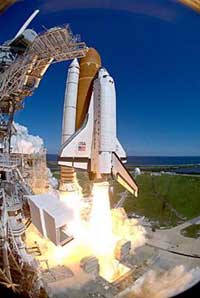 |
|
The Space Shuttle Discovery launching into space |
The year 2005 was marked by many remarkable scientific events. The Guardian (UK) has published a list of the top 10 scientific breakthroughs of the past year.
Human Chromosome Implantation into Mice
Genetics continued to be a hot topic in science in 2005 with the creation of the world’s first mouse containing human chromosomes. Scientist Elizabeth Fisher from the Institute of Neurology and Victor Tybulewicz from the National Institute for Medical Research in London implanted a copy of the human chromosome 21 into mice. This new mouse model allowed researchers to study which genes on chromosome 21 control the various symptoms of Down syndrome.
Impact on Celestial Bodies
In July, Americans successfully directed the Deep Impact spacecraft to launch an automated station into Comet Tempel 1, creating a crater that allowed scientists to observe the interior of a moving celestial body for the first time. Last month, Japan’s Hayabusa spacecraft successfully landed on an asteroid named Itokawa.
Cosmic Simulation on Computers
With a memory capacity of 25 million megabytes, the Millennium Simulation program (a collaboration among astrophysicists from the UK, Germany, the US, and Canada) is the largest program to simulate the formation and evolution of the universe. Programmed under known conditions, this simulation recreated the 14 billion-year history of the universe within a few months, providing insights into why the universe is structured as it is today.
Space Shuttle Returns to Orbit
In the past year, NASA successfully launched the Space Shuttle Discovery into space after the shuttle program had been interrupted since the Columbia disaster in 2003.
Recreation of the 1918 Flu Virus
In October, American scientists successfully recreated the strain of the influenza virus responsible for the 1918 Spanish flu pandemic, which claimed 50 million lives. Research revealed that the 1918 strain, originally a pure avian virus, had adapted to infect humans. This finding raised concerns about the potential for a similar pandemic should the current H5N1 avian flu virus mutate.
Huygens Probe Lands on Saturn’s Moon
The discovery of Saturn’s moon Titan was a major success for scientists this year. The successful landing of the Huygens probe after a nearly 2 billion-mile journey over seven years revealed that Titan’s surface structure is quite similar to that of Earth.
Human Cloning in the UK
After the research of Professor Hwang Woo Suk was concluded to be fraudulent, scientists in Newcastle, England, became the first to successfully clone human embryos. Using 36 surplus eggs from women undergoing fertility treatments, the Newcastle scientists created ten cloned embryos, providing hope for deriving compatible stem cells for patients.
Intelligent Design Theory Banned in the US
The theory of Intelligent Design, which posits that life was created by a supernatural being or higher entity, was ruled unconstitutional by a US court in Pennsylvania and banned from being taught in the Dover School District.
The Hottest Year on Record
Scientists in Southampton provided the first evidence that the Gulf Stream, which brings mild weather to England, is gradually slowing down; Arctic ice has now decreased to just 80% of what NASA recorded in its first photographs in 1978. The year 2005 was also recorded as the hottest year ever.
Singing Mice and Lucky Red
Tim Holy and Zhongsheng Guo from the University of Washington in Missouri discovered that male mice sing in melodies resembling songs when they smell the urine of a mate. Meanwhile, British scientists found that soccer players wearing red jerseys have a higher chance of winning.
TRANSLATED BY THANH TRUC


















































